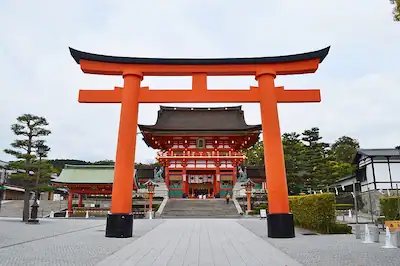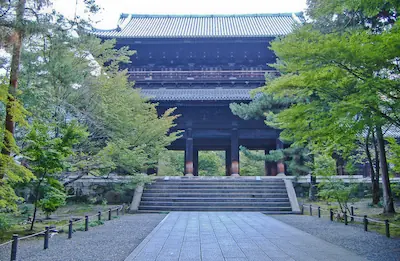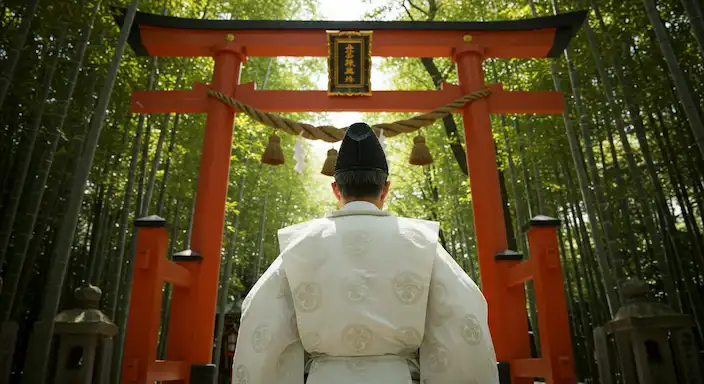A Comprehensive Guide of the Differences of Jingū, Taisha, and Tenmangū
For people outside of Japan, it’s common to think that there’s only one type of Shinto shrine.
But in reality, there are various kinds of shrines!
If you’re planning to travel to Japan and visit shrines, understanding the different types will deepen your understanding of the country.
So, this time, I’d like to explain the types of shrines.
Table of Contents
When traveling in Japan or even just in daily life, we Japanese people encounter many different shrines.
Ise Jingū, Izumo Taisha, Kitano Tenmangū… Even for those outside of Japan, you might have heard these names.
There are said to be anywhere from 80,000 to over 100,000 shrines across Japan, showing how deeply rooted they are in Japan’s landscape and culture.
But have you ever wondered why they aren’t just called “Jinja” (Shrine), but also have different names like “Jingū,” “Taisha,” or “Tenmangū”? Does that mean something?
Is there perhaps a kind of ranking system? This time, I will explain the basic knowledge about shrines in an easy-to-understand way.
Starting with the basics of what a shrine is, we will delve into the meaning of the different titles (shagō) used for various shrines, and the historical ranking system for shrines known as “社格” (shakaku).
With this knowledge, your visits to shrines are sure to become more profound and interesting.
What is a Shrine? The Absolute Basics
The Abode of the Deities: The World of Kami
First, let’s look at the definition of a “Jinja” (Shrine).
A Jinja is a facility for the worship of the Kami (deities or spirits) of Shinto (Shintō), Japan’s indigenous religion.
A characteristic of Shinto is its polytheism, believing in the existence of many Kami.
As the phrase “八百万の神” (yaoyorozu no kami) suggests, the number is considered immense – literally, “eight million gods,” but implying countless numbers.
So, what kind of beings are worshipped as Kami?
Since ancient times, Japanese people have believed that Kami dwell in nature itself, such as mountains, seas, rivers, forests, rocks, and trees, as well as in natural phenomena like fire, water, wind, and the earth.
This reverence for nature forms the core of Shinto’s nature worship.
Furthermore, Kami include deities appearing in myths like the Kojiki (enjin chigi), ancestral deities of the Imperial family and clans (祖神 – soshin), historical great figures who achieved remarkable things, and even certain animals.
The origins of shrines are said to lie in rituals performed at sacred rocks or boulders where Kami were believed to descend (iwakura), or in places marked off and enclosed with evergreen trees to designate a sacred area (himorogi).
These were forms of belief tied to specific locations and did not necessarily involve permanent buildings.
Modern shrines with main halls (shaden) are thought to have developed from these temporary ritual sites becoming permanent.
Some older shrines may lack a main hall, which is believed to be a remnant of this history.
In Shinto, Kami are often considered invisible beings and are not always represented as idols (神像).
The sacred object housed deep within the shrine’s main hall (honden) is called the 御神体 (goshintai), considered a vessel or object where the Kami resides (yorishiro).
It can take various forms such as mirrors, swords, jewels, or gohei (paper or cloth streamers).
Occasionally, natural objects like mountains, rocks, or waterfalls are themselves considered the Goshintai.
Because the Goshintai is extremely sacred, it is usually not visible to the public.
This contrasts with Buddhist temples, where Buddha statues (butsuzō) are often enshrined in a way that is visible to worshippers.
This difference may reflect that Shinto tends to emphasize the unseen “presence” or “existence” of the Kami, whereas certain schools or forms of Buddhism utilize visual representations more frequently.
Differences Between Shrines and Temples
In Japan, there are religious facilities similar to shrines called “Otera”, or Buddhist temples.
These two are often confused, but they are fundamentally different.
The biggest difference is the religion they are associated with.
Shrines are facilities for “Shinto,” while temples are facilities for “Buddhism.”
Differences are also visible in their appearance and structure.
At the entrance of a shrine, you will usually find a “鳥居” (torii), a symbolic gate that marks the boundary between the sacred realm of the shrine and the secular world.
The gate of a temple, on the other hand, is called a “山門” (sanmon) or similar, and its form is different. Also, temples house Buddha statues and often have cemeteries (bochi) on their grounds, whereas shrines generally do not conduct funerals and rarely have cemeteries within their precincts.
This is because Shinto has a concept of avoiding death as a form of “穢れ” (kegare), or impurity.
The people who work there are also different.
At shrines, people called “神職” (shinshoku) or “神主” (kannushi) (Shinto priests) serve and perform rituals, prayers (kitō ), and administrative duties.
Women called “巫女” (miko) (shrine maidens) may assist the priests.
At temples, there are “僧侶” (sōryo) or “お坊さん” (obōsan) (Buddhist monks/priests) who chant sutras (読経 – dokkyō), practice asceticism, preach Buddhist teachings (seppō), and manage funerals and cemeteries.
The method of worship (sanpai) also differs.
At shrines, it is generally practiced with the “二礼二拍手一礼” (nirei nihakushu ichirei) etiquette (bow twice, clap your hands twice, bow once).
At temples, it is common to quietly bring your hands together (gasshō) without clapping.
Historically, however, a long period of “神仏習合” (shinbutsu shūgō), or the syncretism of Shinto and Buddhism, occurred, where Shinto Kami and Buddhist Hotoke (Buddhas) were sometimes seen as the same, or where their facilities influenced each other.
As a result, some elements cannot be completely separated, but in modern times, they are clearly distinguished as religious facilities.
The presence or absence of a Torii, the presence or absence of clapping during worship, and whether the staff are Shinto priests or Buddhist monks are easy ways to distinguish whether you are visiting a shrine or a temple.

Photo: Wikipedia

Photo: Wikipedia
Why Do People Visit Shrines? A Place of Gratitude and Connection
People visit shrines for various reasons.
Many visit to make specific wishes, such as for success in exams, business prosperity, family safety, good health, or finding a partner. However, the original role of a shrine is also said to be to convey gratitude to the Kami for daily life.
Japan’s belief in “Yaoyorozu no Kami” (myriad deities) is closely linked to gratitude towards nature.
It is believed that Kami reside in all natural objects and phenomena, and that our lives are sustained by the blessings of nature, which is to say, thanks to the Kami.
Shrines exist as places to express this feeling of gratitude.
Furthermore, shrines are not only places for individual faith but also deeply connected to local communities and culture.
They are used as venues for life cycle events such as the first shrine visit of the New Year (hatsumōde), the Shichi-Go-San festival for children, and Shinto-style weddings (shinzen-shiki).
They also serve as the center for local festivals (reisai), acting as a core gathering place for people.
In recent years, they have also gained attention as “power spots” for healing mind and body.
Thus, shrines are not merely places for making wishes, but important spaces for offering gratitude to the Kami, connecting people with nature, their communities, and culture, and serving as a spiritual anchor.
Having both the aspect of a place for personal prayer and the aspect of a place for communal cultural and social activities is one reason why shrines are deeply rooted in Japanese society.
Deciphering Shrine Names: Jingū, Taisha, Miya… (Shagō)
The part following a shrine’s name, such as “〇〇 Jingū,” “〇〇 Taisha,” or “〇〇 Jinja,” is called the “社号” (shagō).
This is a title that indicates the shrine’s history and status, the type of deity enshrined (saijin), and so on.
While the “社格” (shakaku), a formal ranking system by the state, has now been abolished, the shagō retains its legacy and still serves as a clue to understanding a shrine’s character.
神宮 (Jingū): Deep Connections with the Imperial Family
“Jingū” is one of the highest status shagō.
It is mainly used for shrines that enshrine the ancestral deities of the Imperial family (kōsojin), such as Amaterasu Ōmikami, successive Emperors, or deities particularly deeply connected to the Imperial family.
When simply referring to “Jingū,” it often specifically means Ise no Jingū (Ise Jingū), which enshrines Amaterasu Ōmikami and Toyouke Ōkami.
Ise Jingū is considered a unique and special entity above all other shrines.
Other representative Jingū include Meiji Jingū (Tokyo), which enshrines Emperor Meiji and Empress Shōken; Heian Jingū (Kyoto), enshrining Emperor Kanmu and Emperor Kōmei; Kashihara Jingū (Nara), enshrining Emperor Jinmu; and Kashima Jingū (Ibaraki) and Katori Jingū (Chiba), which enshrine deities from Japanese mythology.
However, there are shrines that enshrine Emperors but do not have “Jingū” in their name, and conversely, there are examples of shrines using the title “Jingū” even without enshrining Imperial ancestral deities.
It seems that this is due more to historical circumstances and tradition than strict regulations.
宮 (Miya / Gū): Imperial Family and Historical Greats
“Miya” is also a high-status shagō and, similar to “Jingū,” can be used for shrines that enshrine Emperors, members of the Imperial family, particularly Imperial Princes (shinnō).
Furthermore, and importantly, “Miya” is also a title used for shrines that enshrine important historical figures as Kami.
Prime examples are “天満宮” (Tenmangū), which enshrines Sugawara no Michizane, known as the deity of learning, and “東照宮” (Tōshōgū), which enshrines Tokugawa Ieyasu, the founder of the Edo shogunate.
Also, shrines that enshrine Hachiman-shin, with Emperor Ōjin considered the main deity, are called “八幡宮” (Hachimangū).
Hachimangū were widely worshipped as guardian deities of the samurai class.
大社 (Taisha / Ōyashiro): Great Shrines Central to a Region or Deity
The shagō “Taisha” originally often referred specifically to Izumo Taisha in Shimane Prefecture, known for the Kuni-yuzuri myth, which enshrines Ōkuninushi no Mikoto.
Izumo Taisha is sometimes specially read as “Ōyashiro.”
After World War II, when the shakaku system was abolished, the shagō were reorganized. At that time, the title “Taisha” came to be used not only for Izumo Taisha but also for shrines that are the center (sōhonsha) of worship for a specific deity or for large, historically significant shrines that are particularly revered in a region.
Representative examples include Kasuga Taisha in Nara Prefecture, Suwa Taisha in Nagano Prefecture, Sumiyoshi Taisha in Osaka Prefecture, and Fushimi Inari Taisha in Kyoto Prefecture.
The expansion of the “Taisha” shagō after the war may have occurred as a way to recognize the de facto importance and widespread faith of shrines using existing titles, substituting for the abolished old shakaku system.
神社 (Jinja): The Most Common Shagō
“Jinja” is the most common and numerous shagō.
The majority of shrines throughout Japan use this title. Rather than indicating a special history or status, it is widely used as a general term referring to facilities that enshrine Shinto Kami.
Names often consist of a place name or the name of the enshrined deity.
Other Shagō: Daijingū, Sha, etc.
Besides the above, there are a few other shagō.
“大神宮” (Daijingū) can be used for shrines that have a connection to Amaterasu Ōmikami or Toyouke Ōkami enshrined at Ise Jingū, or important shrines where the spirit of the Kami has been divided and enshrined from Ise Jingū (bunrei).
For example, Tokyo Daijingū is famous.
“社” (Sha / Yashiro) may be used for relatively small shrines or places where Kami are worshipped with an altar but without specific buildings.
Also, although not strictly shagō, terms like “大明神” (Daimyōjin) and “権現” (Gongen) exist. These were influenced by the period of Shinto-Buddhist syncretism and are sometimes used as names for Kami or as common names for shrines themselves.
Shagō Indicating Specific Deities: Tenmangū, Hachimangū, Inari Jinja
Some shagō directly indicate the type of Kami (saijin) being enshrined.
These represent major lines of belief with many affiliated shrines nationwide.
天満宮 (Tenmangū) / 天神社 (Tenjinsha)
These shrines enshrine Sugawara no Michizane, a scholar and politician from the Heian period.
As Michizane was highly accomplished in academics, he is widely worshipped as the “god of learning,” and shrines are particularly crowded with worshippers during exam season.
Kitano Tenmangū in Kyoto and Dazaifu Tenmangū in Fukuoka are especially famous as the main shrines (sōhonsha), and together with Hōfu Tenmangū in Yamaguchi Prefecture, they are sometimes called the “Three Great Tenjin of Japan.”
八幡宮 (Hachimangū) / 八幡神社 (Hachiman Jinja)
These shrines enshrine Hachiman-shin.
Hachiman-shin is often identified with Emperor Ōjin, the 15th Emperor, and is commonly enshrined together with his mother Empress Jingū and Hime Ōkami.
In the past, they were deeply revered by the samurai class, such as the Minamoto clan, as a deity for military fortune and victory.
Today, they are widely worshipped for warding off bad luck, bringing good fortune, and ensuring victory.
Usa Jingū in Oita Prefecture is considered the main shrine (sōhongū) for about 40,000 Hachiman shrines nationwide, and Iwashimizu Hachimangū in Kyoto Prefecture and Tsurugaoka Hachimangū in Kanagawa Prefecture are also famous.
Hachiman worship is particularly widespread among shrines, and their numbers are very large.
稲荷神社 (Inari Jinja)
These shrines enshrine Inari Ōkami, also known as Uka no Mitama no Kami, among other deities.
Originally the deity of bountiful harvests and agriculture, over time, Inari became worshipped as the deity of industry, commerce, and business prosperity.
The consecutive red torii gates (senbon torii, thousand torii) and the statues of foxes, considered messengers (kenzoku ) of the deity, are well-known symbols.
However, it’s important to note that the fox is merely a messenger and not the deity itself.
Fushimi Inari Taisha in Kyoto is the main shrine (sōhongū) for about 30,000 Inari shrines nationwide.
Along with Fushimi Inari Taisha, Toyokawa Inari in Aichi Prefecture (though this one is a Buddhist temple), Kasama Inari Shrine in Ibaraki Prefecture, and Yūtoku Inari Shrine in Saga Prefecture are often mentioned as candidates for the “Three Great Inari.”
These shagō provide important clues to understanding the background of the shrines you visit.
If it’s a “Jingū,” it suggests a connection to the Imperial family; a “Tenmangū” suggests Sugawara no Michizane and academics, and so on.
From the shagō, you can glimpse a part of the shrine’s character and history.
Summary of Common Shrine Shagō
| Shagō (Reading) | Main Meaning / Association | Representative Examples (Deities, etc.) |
| 神宮 (Jingū) | Enshrines ancestral deities of the Imperial family, Emperors, or deities deeply connected to the Imperial family. Considered highest status. | Ise Jingū (Amaterasu Ōmikami Toyouke Ōkami) Meiji Jingū (Emperor Meiji) Kashima Jingū (Takemikazuchi Ōkami) |
| 宮 (Miya / Gū) | Enshrines Imperial family members (especially Imperial Princes) or important historical figures. | Nikko Tōshōgū (Tokugawa Ieyasu) |
| 大社 (Taisha / Ōyashiro) | Originally Izumo Taisha. Now, main shrines of specific beliefs or large, historical shrines revered in a region. | Izumo Taisha (Ōkuninushi no Mikoto) Kasuga Taisha (Kasuga Kami) Suwa Taisha (Takeminakata no Kami) |
| 神社 (Jinja) | The most common shagō for a wide range of shrines. Does not indicate a specific high status. | Numerous throughout the country (e.g., a local shrine, a shrine enshrining △△ Kami) |
| 社 (Sha / Yashiro) | Refers to comparatively small shrines or places of worship with altars. | Small local shrines or altars |
| 大神宮 (Daijingū) | Shrines deeply related to Ise Jingū (Amaterasu Ōmikami, Toyouke Ōkami). | Tokyo Daijingū Izumo Daijingū |
| 天満宮 (Tenmangū) | Enshrines Sugawara no Michizane (deity of learning). | Kitano Tenmangū Dazaifu Tenmangū Osaka Tenmangū |
| 八幡宮 (Hachimangū) | Enshrines Hachiman-shin (Emperor Ōjin, etc., deity of martial fortune/warding off evil). | Usa Jingū Iwashimizu Hachimangū Tsurugaoka Hachimangū |
| 稲荷神社 (Inari Jinja) | Enshrines Inari Ōkami (deity of bountiful harvests/business prosperity). | Fushimi Inari Taisha |
Hierarchy in History: What is Shakaku?
Although not used today, shrines once had a hierarchy or ranking called “社格” (shakaku).
This was determined based on the shrine’s importance, its relationship with the state (the Imperial court or government), and its historical origins.
The changes in the shakaku system reflect the relationship between religion and power throughout different eras.
Ancient and Medieval Shakaku Systems
There are several representative shakaku systems from older times.
式内社 (Shikinaisha)
These are shrines listed in the “神名帳” (Jinmyōchō) within the Engishiki (延喜式), a detailed code of regulations compiled in the mid-Heian period (10th century).
These were shrines officially recognized by the Imperial court at the time and received offerings (heihaku).
Being a Shikinaisha is considered proof that a shrine has a legitimate history dating back to ancient times.
Ise Jingū, Kashima Jingū, Katori Jingū, and Suwa Taisha are examples.
二十二社 (Nijūnisha)
This is another system from the Heian period, referring to 22 important shrines where the Imperial court offered special prayers when major events occurred (such as natural disasters or epidemics).
Ise Jingū, Iwashimizu Hachimangū, Kamo Shrines (Kamigamo and Shimogamo), and Kasuga Taisha are included.
一宮 (Ichinomiya)
From the late Heian period to the Kamakura period, this referred to the shrine considered to have the highest status in each ryōseikoku (令制国), the historical provincial administrative divisions of Japan.
For example, Ōmiwa Jinja was considered the Ichinomiya of Yamato Province (present-day Nara Prefecture).
Ichinomiya were the center of faith in their region and were the first shrines visited by the provincial governor (kokushi ).
Modern Shakaku System (Meiji Restoration – 1945)
After the Meiji Restoration, the government promoted policies positioning Shinto as the spiritual pillar of the state (State Shinto – Kokka Shintō).
As part of this, a new shakaku system was established to rank shrines nationwide.
Unlike previous systems, this was more systematic and had a stronger element of state control.
The main classifications were as follows:
官社 (Kansha): Shrines that received special treatment from the state.
- 官幣社 (Kanpeisha)
Shrines that received heihaku (offerings) from the Imperial Household Ministry.
Shrines closely connected to the Imperial family were designated as such. - 国幣社 (Kokuheisha)
Shrines that received heihaku from the national treasury.
These were mainly important shrines in various regions.
Both Kanpeisha and Kokuheisha were further divided into ranks: 大社 (taisha), 中社 (chūsha), and 小社 (shōsha) (e.g., Kanpei Taisha, Kokuhei Chūsha).
Kanpei Taisha held the highest rank in this system. - Additionally, a category called 別格官幣社 (Bekkaku Kanpeisha) was established for shrines enshrining individuals who had rendered meritorious service to the state.
諸社 (Shosha): Shrines other than Kansha, associated with local governments such as prefectures, cities, or towns.
- There was a hierarchy: 府社/県社/藩社 (Fusha/Kensha/Hansha)
- 郷社 (Gōsha)
- 村社 (Sonsha)
- 無格社 (Mukakusha): Shrines not included in any of the above ranks.
These were mostly small shrines, and many were consolidated or abolished under the shrine consolidation policy (Jinja Gōshi) in the late Meiji period.
This modern shakaku system served to support the State Shinto regime by placing shrines under state control and organizing them into a hierarchy.
Abolition of the Shakaku System and its Influence
After Japan’s defeat in World War II and the subsequent occupation by the General Headquarters of the Allied Powers (GHQ), emphasis was placed on freedom of religion and the principle of separation of church and state (seikyō bunri).
The State Shinto system was dismantled, and consequently, the shakaku system, which was the state’s ranking of shrines, was also abolished in 1946.
As a result, all shrines are legally treated as equal religious corporations.
However, the abolition of the shakaku system did not erase the historical importance or the position of each shrine in people’s faith.
Even today, historical descriptions and information boards at shrines often mention their former shakaku, such as “旧官幣大社” (kyū kanpei taisha – former Kanpei Taisha) or “旧県社” (kyū kensha – former Kensha).
This indicates the shrine’s past status and continues to hold cultural significance as a marker of historical honor and tradition.
Even though their legal effect is lost, the “prestige” or “lineage” associated with the historical ranking continues to exist in people’s perception.
Modern Classification: Beppyō Jinja
After the abolition of the shakaku system, the Association of Shinto Shrines (Jinja Honchō) was established as a religious corporation encompassing many shrines nationwide.
While Jinja Honchō generally treats all shrines equally (except for Ise Jingū), it has special regulations regarding the personnel appointments (such as the chief priest (gūji) or associate chief priest (gon-gūji ) )for a select group of particularly prominent and historically significant shrines.
These shrines that receive special treatment are listed in the “別表” (beppyō – appendix or list) of the Jinja Honchō regulations and are therefore called “別表に掲げる神社” (beppyō ni kakageru jinja – shrines listed in the appendix), commonly known as “別表神社” (Beppyō Jinja).
The criteria for being selected as a Beppyō Jinja include the shrine’s history, the state of its buildings and grounds, the number of full-time Shinto priests, financial situation, activities, and the number of parishioners or worshippers (ujiko/sūkeisha).
Initially, the list was primarily made up of former Kanpeisha and Kokuheisha, but other influential shrines that met the criteria were added later.
Currently, over 350 shrines are designated.
Examples include prominent shrines nationwide such as Tōgō Jinja (Tokyo), Nogi Jinja (Tokyo), Atsuta Jingū (Aichi), Izumo Taisha (Shimane), and Usa Jingū (Oita).
It is important to understand that this “Beppyō Jinja” classification is solely for the administrative and operational convenience within Jinja Honchō and is not a revival of the shakaku system.
It does not indicate a legal hierarchy or superiority.
However, as a result, many shrines with high former shakaku or historical importance are included, so it is sometimes perceived as a de facto indicator of a shrine’s scale and influence.
This can be seen as a practical mechanism within the Shinto world to deal with the real-world differences in shrine size and historical background while adhering to the post-war principle of separation of church and state.
Understanding Diversity, Enriching Your Visit
As we have seen, even though we use the single term “Jinja” (Shrine), there is a rich diversity behind it.
A shrine is a place that enshrines the Kami of Shinto, and there are various types of Kami, including those from nature, mythology, ancestors, and historical figures.
Shrines have clear differences from Buddhist temples in terms of the religion they follow, their architecture (like the presence of a Torii), and rituals (like clapping during worship).
The “社号” (shagō) that follows a shrine’s name (Jingū, Miya, Taisha, Jinja, etc.) provides clues to understanding the shrine’s enshrined deity, history, and historical position. Specifically, “Jingū” indicates a connection to the Imperial family, “Miya” indicates Imperial family members or important historical figures, and “Tenmangū,” “Hachimangū,” and “Inari Jinja” indicate specific types of Kami.
The “社格” (shakaku) system that once existed was a historical ranking reflecting the relationship between the state and shrines, and it has now been abolished.
However, its memory remains in the form of “旧社格” (kyū shakaku – former shakaku), which can indicate a shrine’s historical prestige.
The modern “別表神社” (Beppyō Jinja) is an administrative classification by Jinja Honchō, different from shakaku.
This knowledge is more than just trivia.
By knowing the origin of a shrine’s name and its historical background, you can gain a deeper understanding of the unique story each shrine possesses, its connection with the local people, and its role in Japanese culture and history.
The next time you visit a shrine, be sure to pay attention to its name (shagō) and the historical information board on the grounds (which might mention its former shakaku).
You will surely see the shrine from a different perspective, and your visit will become even richer.
I hope this becomes a wonderful opportunity for you to feel the diversity and depth of Japan’s spiritual culture.










Leave a Reply